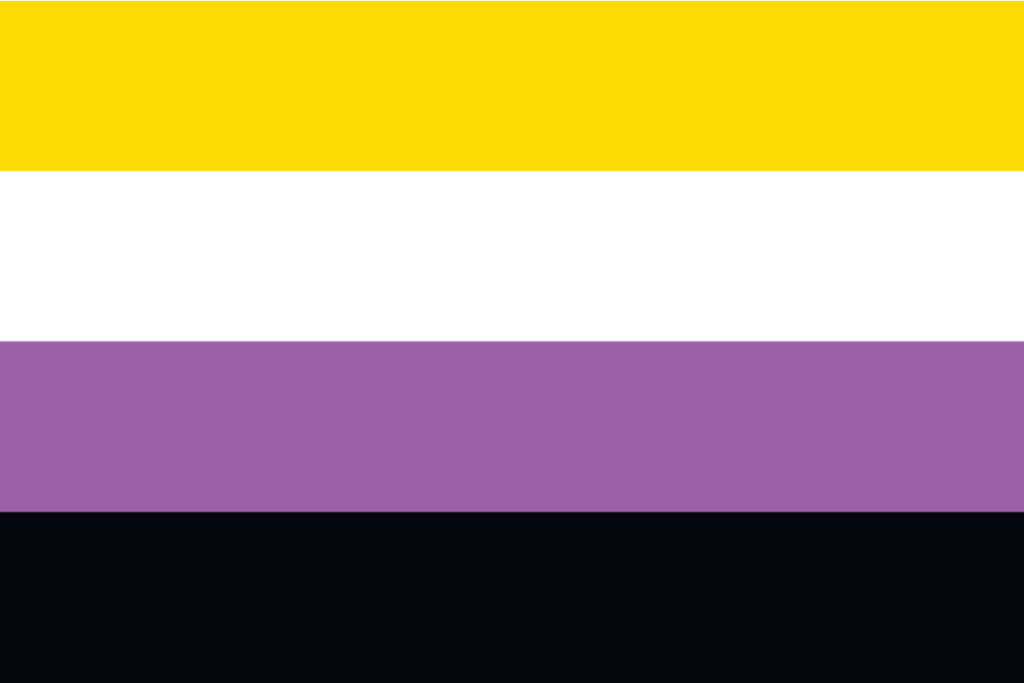Non-Binary Gender, What Does It Mean?

The recent premiere of the third season of the Netflix series Sex Education included a new character, Cal Bowman, who identified as “non-binary”. This sets the stage for the debate about people who embody identities of non-binary gender. Furthermore, the situations they find themselves facing on a day-to-day basis.
However, what does non-binary gender mean? To answer this question, we first have to understand what gender is. Then, we need to understand the relationship between sex and gender. Finally, we must consider the social implications of alternative gender identities in a world that’s apparently organized from a binary logic.
Gender, beyond sex
The word “gender”, by definition, refers to the idea of categorization, classification, and differentiation between different items. Its use in the social sciences covers the need to understand the way in which we constitute ourselves as subjects, beyond the deterministic borders of biological sex.
Therefore, sex would generally refer to the physiological, biological, and anatomical characteristics of bodies. The kind of characteristics that allow an individual to be classified as “male” or “female”. However, gender relates to the historical and sociocultural processes through which a body becomes a “woman” or “man”. It involves the ways in which people incorporate and reproduce the roles and behaviors associated with (and imposed on) each sex.
Consequently, gender is both a social construction and the internalization (or not) of said construction by an individual. This internalization process is linked to the concept of “gender identity”.
We understand gender identity as an individual’s own experience. It’s also socially constituted in respect of how we perceive ourselves in relation to our sexuality. In addition, our ways of experiencing and being in the world. In this sense, our gender identity may or may not match our biological sex.
Thus far, we’ve raised the question of the sex-gender scheme from binary categories. However, sometimes, gender identity not only doesn’t coincide with our biological sex but also doesn’t conform to the prescribed masculine or feminine categorizations. In this case, we’re faced with non-binary gender identity.

Non-binary gender: affirming indeterminacy
We’ve learned to understand the world from a binary logic. Indeed, pairs such as reason/emotion, nature/culture, and mind/body form a constitutive part of modern thought, of which we’re the indisputable heirs.
From the point of view of gender, the dichotomy between masculine (male) and feminine (female) has been fundamental. In fact, it’s traditionally behind the ways in which we’ve tried to understand the relationships between one another, as well as desire, aesthetics, eroticism, and identity.
Gender binarism is sustained within the framework of a cisnormative system. This is a system in which the parameter of “normality” is dictated by the correlation between gender identity and biological sex. For this reason, it indicates as “abnormal” those identities that don’t coincide with the cisgender expectation.
However, during the last decades, non-normative identities have become visible. This fact tends to question gender binarism and the rigidity of a system that only admits two options as valid.
In this way, non-binary gender is a concept that makes it possible to account for those people who don’t identify as either men or women. Nevertheless, this doesn’t necessarily mean that non-binary is an “intermediate” identity between the two ends of the binary spectrum.
As a matter of fact, those who recognize themselves as “non-binaries” may not identify with any gender. For this reason, they may seek a gender-neutral or androgynous expression. On the other hand, they may transition (simultaneously or alternately) between male and female gender expressions.

Peripheral identities
Questioning gender binary from one’s own existence sometimes involves becoming the target of criticism, harassment, and violence. The origins and consequences of such behavior go far beyond the remit of this article. However, it’s certainly worth mentioning as our conclusion.
The sex/gender system is deeply rooted in the processes of identity construction. From there, violence is generated and reproduced against those considered to be non-normative.
The trans community, gender fluid people, and queer people are exposed to physical and symbolic violence along with other forms of discrimination. This all forms a part of the visible reflection of the web of oppression toward those who express alternative gender identity.
Perhaps we should ask ourselves the question, what is it that’s so uncomfortable about gender indeterminacy? Furthermore, what prevents us, as a society, from breaking with binary thinking and opening ourselves to new ways of inhabiting the world? Indeed, why can’t we simply eliminate the dichotomies and structures of domination that rank some bodies and experiences above others?
The recent premiere of the third season of the Netflix series Sex Education included a new character, Cal Bowman, who identified as “non-binary”. This sets the stage for the debate about people who embody identities of non-binary gender. Furthermore, the situations they find themselves facing on a day-to-day basis.
However, what does non-binary gender mean? To answer this question, we first have to understand what gender is. Then, we need to understand the relationship between sex and gender. Finally, we must consider the social implications of alternative gender identities in a world that’s apparently organized from a binary logic.
Gender, beyond sex
The word “gender”, by definition, refers to the idea of categorization, classification, and differentiation between different items. Its use in the social sciences covers the need to understand the way in which we constitute ourselves as subjects, beyond the deterministic borders of biological sex.
Therefore, sex would generally refer to the physiological, biological, and anatomical characteristics of bodies. The kind of characteristics that allow an individual to be classified as “male” or “female”. However, gender relates to the historical and sociocultural processes through which a body becomes a “woman” or “man”. It involves the ways in which people incorporate and reproduce the roles and behaviors associated with (and imposed on) each sex.
Consequently, gender is both a social construction and the internalization (or not) of said construction by an individual. This internalization process is linked to the concept of “gender identity”.
We understand gender identity as an individual’s own experience. It’s also socially constituted in respect of how we perceive ourselves in relation to our sexuality. In addition, our ways of experiencing and being in the world. In this sense, our gender identity may or may not match our biological sex.
Thus far, we’ve raised the question of the sex-gender scheme from binary categories. However, sometimes, gender identity not only doesn’t coincide with our biological sex but also doesn’t conform to the prescribed masculine or feminine categorizations. In this case, we’re faced with non-binary gender identity.

Non-binary gender: affirming indeterminacy
We’ve learned to understand the world from a binary logic. Indeed, pairs such as reason/emotion, nature/culture, and mind/body form a constitutive part of modern thought, of which we’re the indisputable heirs.
From the point of view of gender, the dichotomy between masculine (male) and feminine (female) has been fundamental. In fact, it’s traditionally behind the ways in which we’ve tried to understand the relationships between one another, as well as desire, aesthetics, eroticism, and identity.
Gender binarism is sustained within the framework of a cisnormative system. This is a system in which the parameter of “normality” is dictated by the correlation between gender identity and biological sex. For this reason, it indicates as “abnormal” those identities that don’t coincide with the cisgender expectation.
However, during the last decades, non-normative identities have become visible. This fact tends to question gender binarism and the rigidity of a system that only admits two options as valid.
In this way, non-binary gender is a concept that makes it possible to account for those people who don’t identify as either men or women. Nevertheless, this doesn’t necessarily mean that non-binary is an “intermediate” identity between the two ends of the binary spectrum.
As a matter of fact, those who recognize themselves as “non-binaries” may not identify with any gender. For this reason, they may seek a gender-neutral or androgynous expression. On the other hand, they may transition (simultaneously or alternately) between male and female gender expressions.

Peripheral identities
Questioning gender binary from one’s own existence sometimes involves becoming the target of criticism, harassment, and violence. The origins and consequences of such behavior go far beyond the remit of this article. However, it’s certainly worth mentioning as our conclusion.
The sex/gender system is deeply rooted in the processes of identity construction. From there, violence is generated and reproduced against those considered to be non-normative.
The trans community, gender fluid people, and queer people are exposed to physical and symbolic violence along with other forms of discrimination. This all forms a part of the visible reflection of the web of oppression toward those who express alternative gender identity.
Perhaps we should ask ourselves the question, what is it that’s so uncomfortable about gender indeterminacy? Furthermore, what prevents us, as a society, from breaking with binary thinking and opening ourselves to new ways of inhabiting the world? Indeed, why can’t we simply eliminate the dichotomies and structures of domination that rank some bodies and experiences above others?
All cited sources were thoroughly reviewed by our team to ensure their quality, reliability, currency, and validity. The bibliography of this article was considered reliable and of academic or scientific accuracy.
- Bodenhofer González, C. (2020). Estructuras de sexo-género binarias y cisnormadas tensionadas por identidades y cuerpos no binarios: Comunidades educativas en reflexión y transformación. Revista Punto Género, (12), pp. 101-125. doi:10.5354/0719-0417.2020.56250.
- Haraway, D. (1995) «Género» para un diccionario marxista: la política sexual de una palabra. En Ciencia, cyborgs y mujeres. La reinvención de la naturaleza. Madrid: Cátedra. Págs. 213-250.
This text is provided for informational purposes only and does not replace consultation with a professional. If in doubt, consult your specialist.







